Cooking the Books: Manipulation of Financial Records
VerifiedAdded on 2023/03/17
|16
|2213
|98
AI Summary
The term cooking the books refers to the manipulation of financial records to make a company's financial results appear better than they actually are. This practice involves inflating earnings and reducing expenses, resulting in higher reported profits. However, cooking the books is illegal and can have severe consequences. Investors rely on auditors to detect and report any fraudulent practices.
Contribute Materials
Your contribution can guide someone’s learning journey. Share your
documents today.
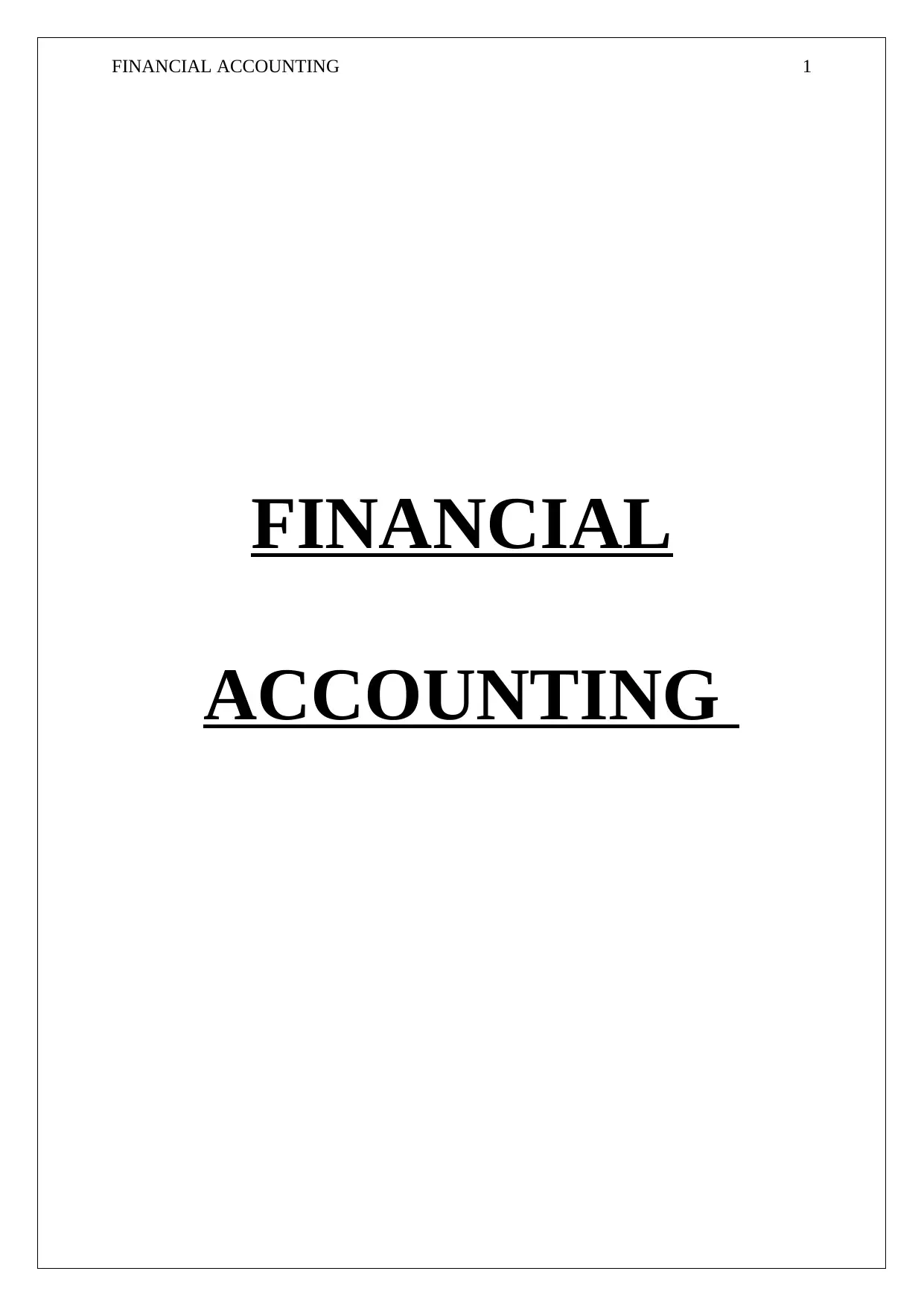
FINANCIAL ACCOUNTING 1
FINANCIAL
ACCOUNTING
FINANCIAL
ACCOUNTING
Secure Best Marks with AI Grader
Need help grading? Try our AI Grader for instant feedback on your assignments.
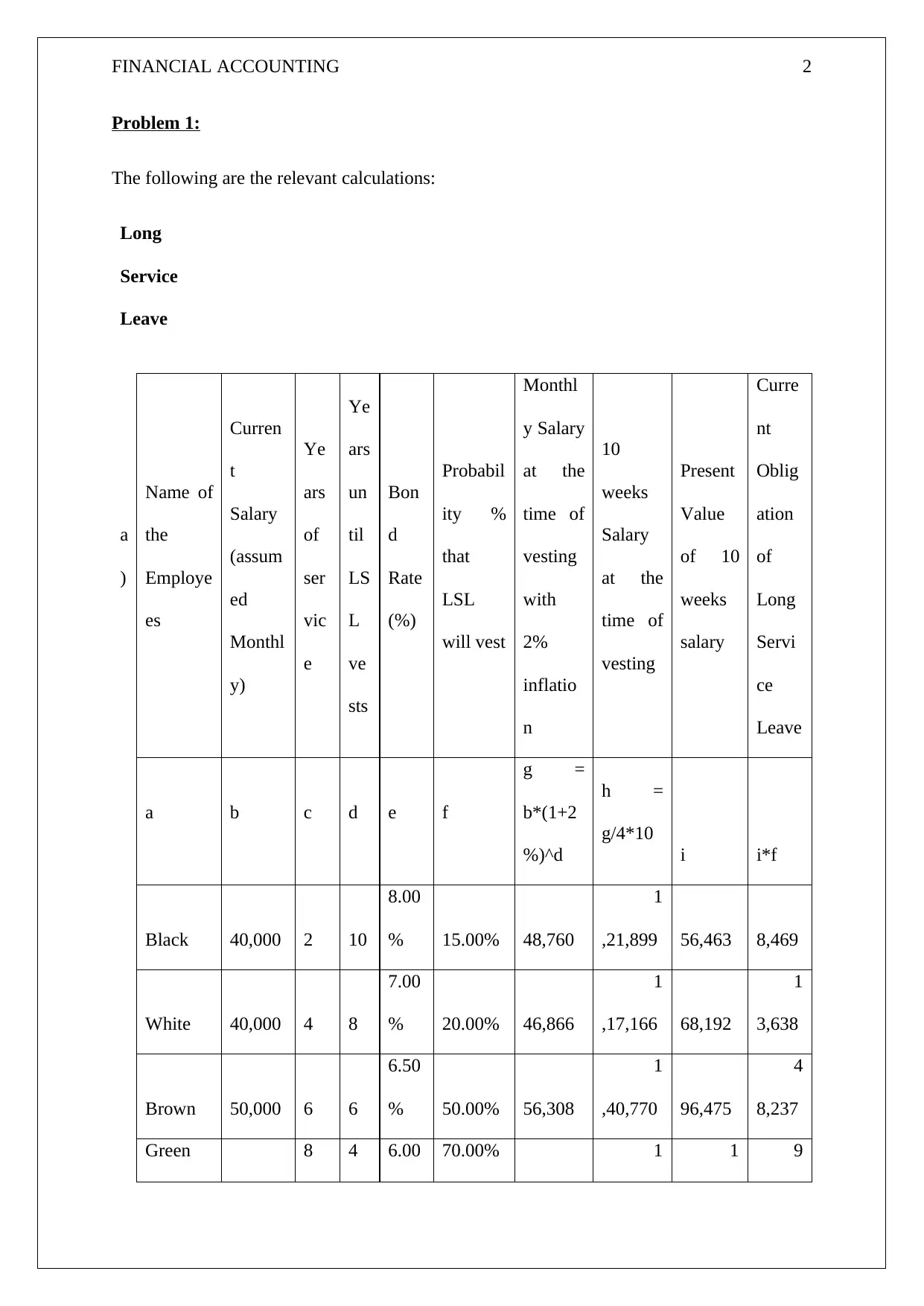
FINANCIAL ACCOUNTING 2
Problem 1:
The following are the relevant calculations:
Long
Service
Leave
a
)
Name of
the
Employe
es
Curren
t
Salary
(assum
ed
Monthl
y)
Ye
ars
of
ser
vic
e
Ye
ars
un
til
LS
L
ve
sts
Bon
d
Rate
(%)
Probabil
ity %
that
LSL
will vest
Monthl
y Salary
at the
time of
vesting
with
2%
inflatio
n
10
weeks
Salary
at the
time of
vesting
Present
Value
of 10
weeks
salary
Curre
nt
Oblig
ation
of
Long
Servi
ce
Leave
a b c d e f
g =
b*(1+2
%)^d
h =
g/4*10
i i*f
Black 40,000 2 10
8.00
% 15.00% 48,760
1
,21,899 56,463 8,469
White 40,000 4 8
7.00
% 20.00% 46,866
1
,17,166 68,192
1
3,638
Brown 50,000 6 6
6.50
% 50.00% 56,308
1
,40,770 96,475
4
8,237
Green 8 4 6.00 70.00% 1 1 9
Problem 1:
The following are the relevant calculations:
Long
Service
Leave
a
)
Name of
the
Employe
es
Curren
t
Salary
(assum
ed
Monthl
y)
Ye
ars
of
ser
vic
e
Ye
ars
un
til
LS
L
ve
sts
Bon
d
Rate
(%)
Probabil
ity %
that
LSL
will vest
Monthl
y Salary
at the
time of
vesting
with
2%
inflatio
n
10
weeks
Salary
at the
time of
vesting
Present
Value
of 10
weeks
salary
Curre
nt
Oblig
ation
of
Long
Servi
ce
Leave
a b c d e f
g =
b*(1+2
%)^d
h =
g/4*10
i i*f
Black 40,000 2 10
8.00
% 15.00% 48,760
1
,21,899 56,463 8,469
White 40,000 4 8
7.00
% 20.00% 46,866
1
,17,166 68,192
1
3,638
Brown 50,000 6 6
6.50
% 50.00% 56,308
1
,40,770 96,475
4
8,237
Green 8 4 6.00 70.00% 1 1 9
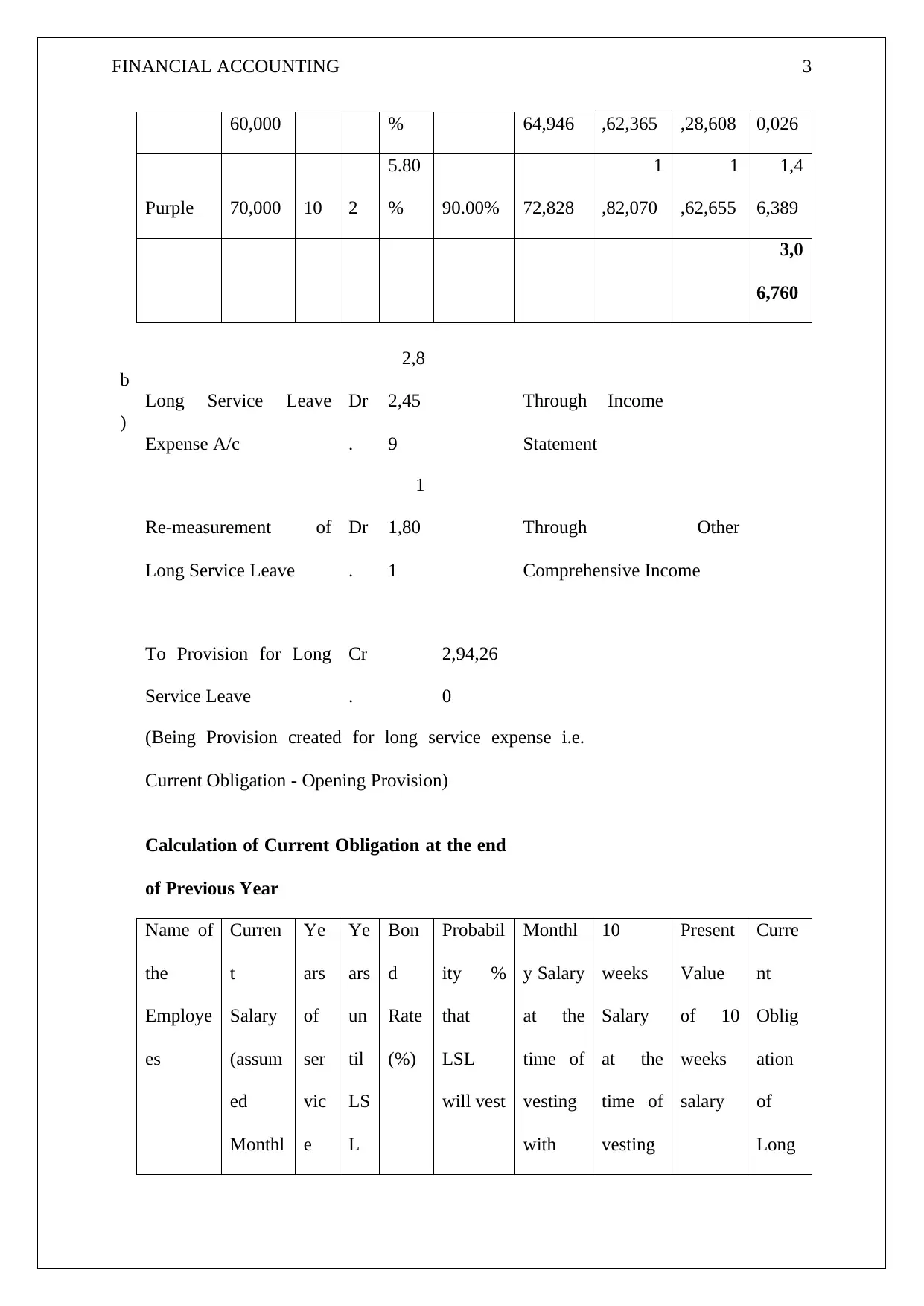
FINANCIAL ACCOUNTING 3
60,000 % 64,946 ,62,365 ,28,608 0,026
Purple 70,000 10 2
5.80
% 90.00% 72,828
1
,82,070
1
,62,655
1,4
6,389
3,0
6,760
b
)
Long Service Leave
Expense A/c
Dr
.
2,8
2,45
9
Through Income
Statement
Re-measurement of
Long Service Leave
Dr
.
1
1,80
1
Through Other
Comprehensive Income
To Provision for Long
Service Leave
Cr
.
2,94,26
0
(Being Provision created for long service expense i.e.
Current Obligation - Opening Provision)
Calculation of Current Obligation at the end
of Previous Year
Name of
the
Employe
es
Curren
t
Salary
(assum
ed
Monthl
Ye
ars
of
ser
vic
e
Ye
ars
un
til
LS
L
Bon
d
Rate
(%)
Probabil
ity %
that
LSL
will vest
Monthl
y Salary
at the
time of
vesting
with
10
weeks
Salary
at the
time of
vesting
Present
Value
of 10
weeks
salary
Curre
nt
Oblig
ation
of
Long
60,000 % 64,946 ,62,365 ,28,608 0,026
Purple 70,000 10 2
5.80
% 90.00% 72,828
1
,82,070
1
,62,655
1,4
6,389
3,0
6,760
b
)
Long Service Leave
Expense A/c
Dr
.
2,8
2,45
9
Through Income
Statement
Re-measurement of
Long Service Leave
Dr
.
1
1,80
1
Through Other
Comprehensive Income
To Provision for Long
Service Leave
Cr
.
2,94,26
0
(Being Provision created for long service expense i.e.
Current Obligation - Opening Provision)
Calculation of Current Obligation at the end
of Previous Year
Name of
the
Employe
es
Curren
t
Salary
(assum
ed
Monthl
Ye
ars
of
ser
vic
e
Ye
ars
un
til
LS
L
Bon
d
Rate
(%)
Probabil
ity %
that
LSL
will vest
Monthl
y Salary
at the
time of
vesting
with
10
weeks
Salary
at the
time of
vesting
Present
Value
of 10
weeks
salary
Curre
nt
Oblig
ation
of
Long
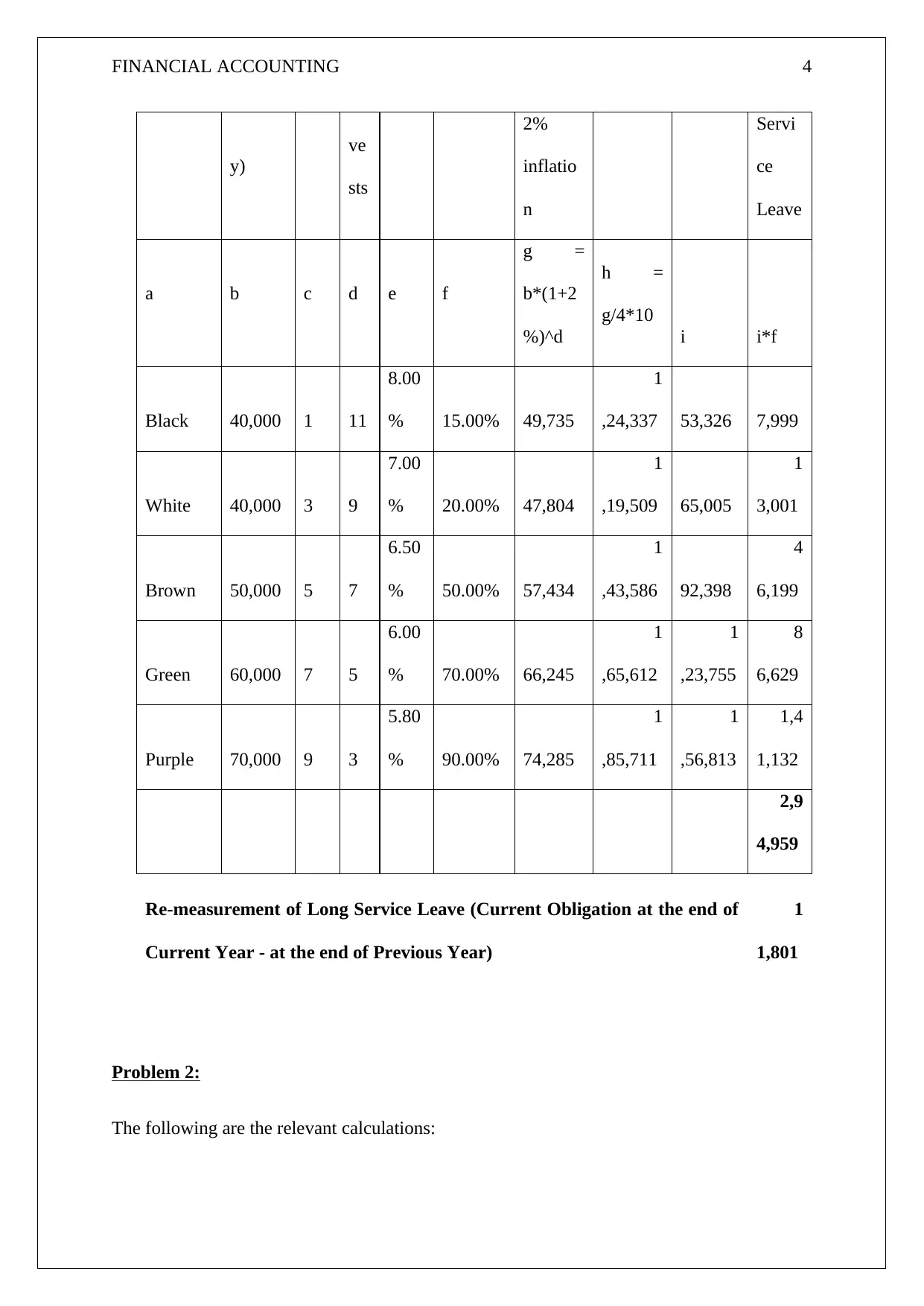
FINANCIAL ACCOUNTING 4
y)
ve
sts
2%
inflatio
n
Servi
ce
Leave
a b c d e f
g =
b*(1+2
%)^d
h =
g/4*10
i i*f
Black 40,000 1 11
8.00
% 15.00% 49,735
1
,24,337 53,326 7,999
White 40,000 3 9
7.00
% 20.00% 47,804
1
,19,509 65,005
1
3,001
Brown 50,000 5 7
6.50
% 50.00% 57,434
1
,43,586 92,398
4
6,199
Green 60,000 7 5
6.00
% 70.00% 66,245
1
,65,612
1
,23,755
8
6,629
Purple 70,000 9 3
5.80
% 90.00% 74,285
1
,85,711
1
,56,813
1,4
1,132
2,9
4,959
Re-measurement of Long Service Leave (Current Obligation at the end of
Current Year - at the end of Previous Year)
1
1,801
Problem 2:
The following are the relevant calculations:
y)
ve
sts
2%
inflatio
n
Servi
ce
Leave
a b c d e f
g =
b*(1+2
%)^d
h =
g/4*10
i i*f
Black 40,000 1 11
8.00
% 15.00% 49,735
1
,24,337 53,326 7,999
White 40,000 3 9
7.00
% 20.00% 47,804
1
,19,509 65,005
1
3,001
Brown 50,000 5 7
6.50
% 50.00% 57,434
1
,43,586 92,398
4
6,199
Green 60,000 7 5
6.00
% 70.00% 66,245
1
,65,612
1
,23,755
8
6,629
Purple 70,000 9 3
5.80
% 90.00% 74,285
1
,85,711
1
,56,813
1,4
1,132
2,9
4,959
Re-measurement of Long Service Leave (Current Obligation at the end of
Current Year - at the end of Previous Year)
1
1,801
Problem 2:
The following are the relevant calculations:
Secure Best Marks with AI Grader
Need help grading? Try our AI Grader for instant feedback on your assignments.
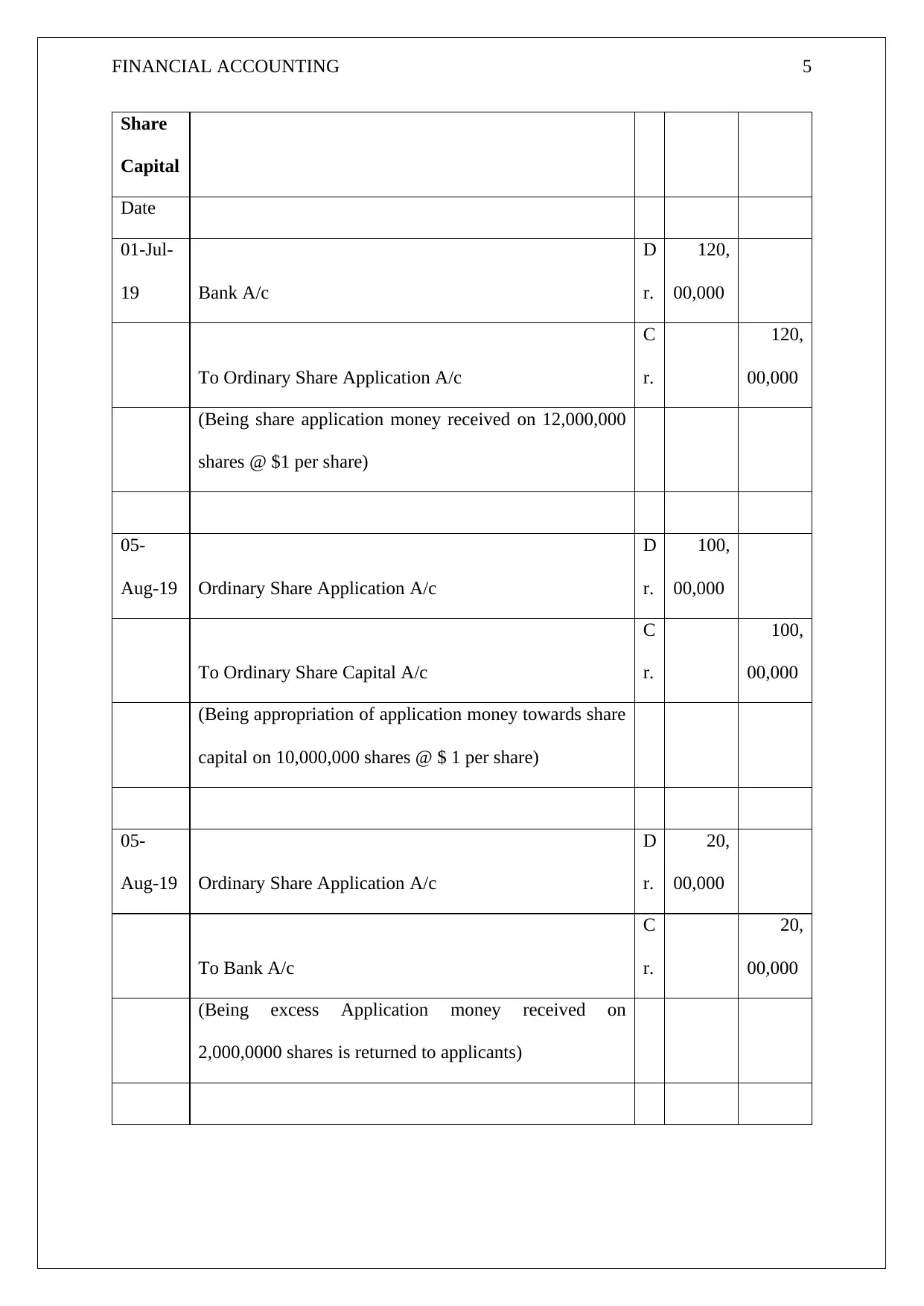
FINANCIAL ACCOUNTING 5
Share
Capital
Date
01-Jul-
19 Bank A/c
D
r.
120,
00,000
To Ordinary Share Application A/c
C
r.
120,
00,000
(Being share application money received on 12,000,000
shares @ $1 per share)
05-
Aug-19 Ordinary Share Application A/c
D
r.
100,
00,000
To Ordinary Share Capital A/c
C
r.
100,
00,000
(Being appropriation of application money towards share
capital on 10,000,000 shares @ $ 1 per share)
05-
Aug-19 Ordinary Share Application A/c
D
r.
20,
00,000
To Bank A/c
C
r.
20,
00,000
(Being excess Application money received on
2,000,0000 shares is returned to applicants)
Share
Capital
Date
01-Jul-
19 Bank A/c
D
r.
120,
00,000
To Ordinary Share Application A/c
C
r.
120,
00,000
(Being share application money received on 12,000,000
shares @ $1 per share)
05-
Aug-19 Ordinary Share Application A/c
D
r.
100,
00,000
To Ordinary Share Capital A/c
C
r.
100,
00,000
(Being appropriation of application money towards share
capital on 10,000,000 shares @ $ 1 per share)
05-
Aug-19 Ordinary Share Application A/c
D
r.
20,
00,000
To Bank A/c
C
r.
20,
00,000
(Being excess Application money received on
2,000,0000 shares is returned to applicants)
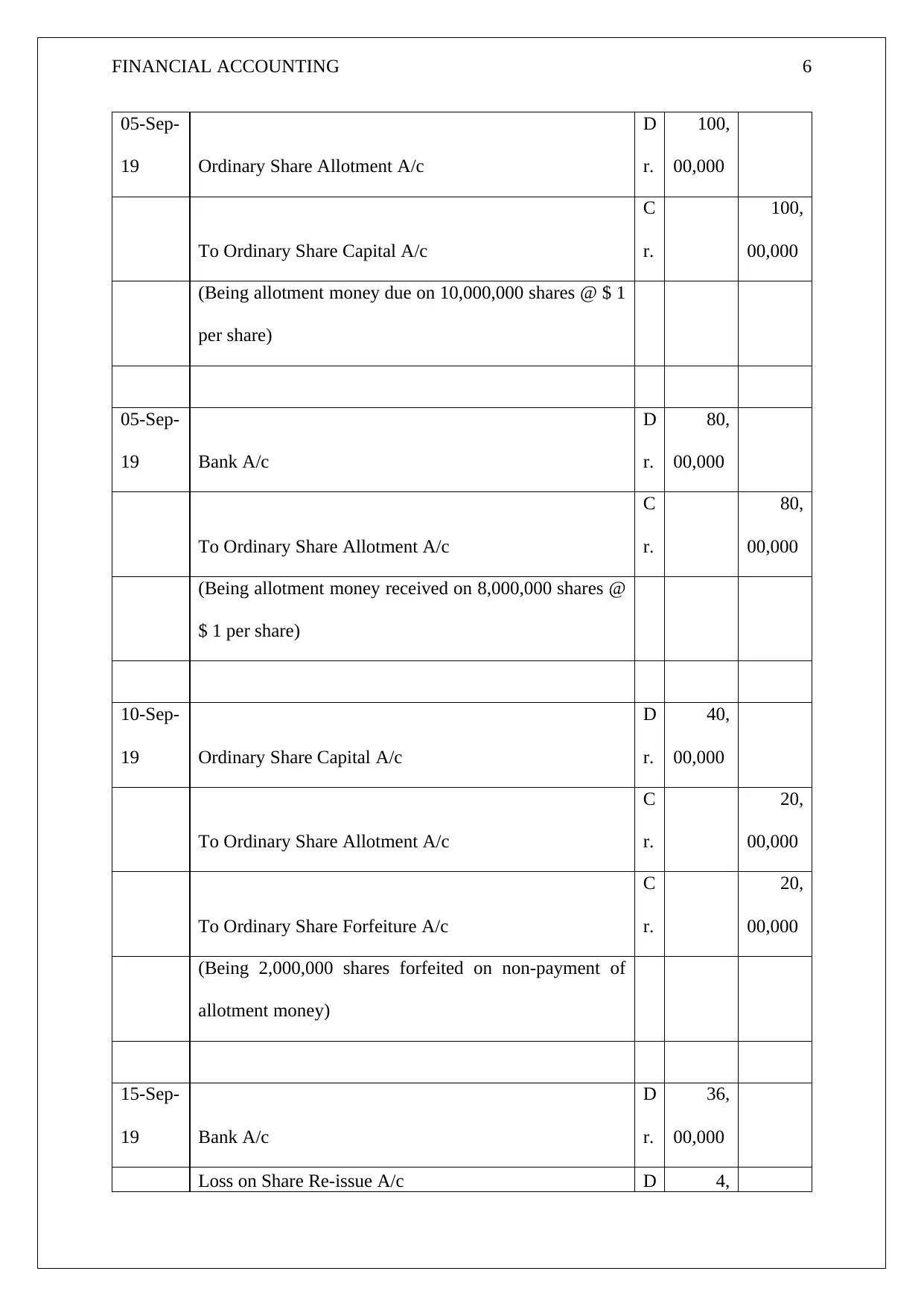
FINANCIAL ACCOUNTING 6
05-Sep-
19 Ordinary Share Allotment A/c
D
r.
100,
00,000
To Ordinary Share Capital A/c
C
r.
100,
00,000
(Being allotment money due on 10,000,000 shares @ $ 1
per share)
05-Sep-
19 Bank A/c
D
r.
80,
00,000
To Ordinary Share Allotment A/c
C
r.
80,
00,000
(Being allotment money received on 8,000,000 shares @
$ 1 per share)
10-Sep-
19 Ordinary Share Capital A/c
D
r.
40,
00,000
To Ordinary Share Allotment A/c
C
r.
20,
00,000
To Ordinary Share Forfeiture A/c
C
r.
20,
00,000
(Being 2,000,000 shares forfeited on non-payment of
allotment money)
15-Sep-
19 Bank A/c
D
r.
36,
00,000
Loss on Share Re-issue A/c D 4,
05-Sep-
19 Ordinary Share Allotment A/c
D
r.
100,
00,000
To Ordinary Share Capital A/c
C
r.
100,
00,000
(Being allotment money due on 10,000,000 shares @ $ 1
per share)
05-Sep-
19 Bank A/c
D
r.
80,
00,000
To Ordinary Share Allotment A/c
C
r.
80,
00,000
(Being allotment money received on 8,000,000 shares @
$ 1 per share)
10-Sep-
19 Ordinary Share Capital A/c
D
r.
40,
00,000
To Ordinary Share Allotment A/c
C
r.
20,
00,000
To Ordinary Share Forfeiture A/c
C
r.
20,
00,000
(Being 2,000,000 shares forfeited on non-payment of
allotment money)
15-Sep-
19 Bank A/c
D
r.
36,
00,000
Loss on Share Re-issue A/c D 4,
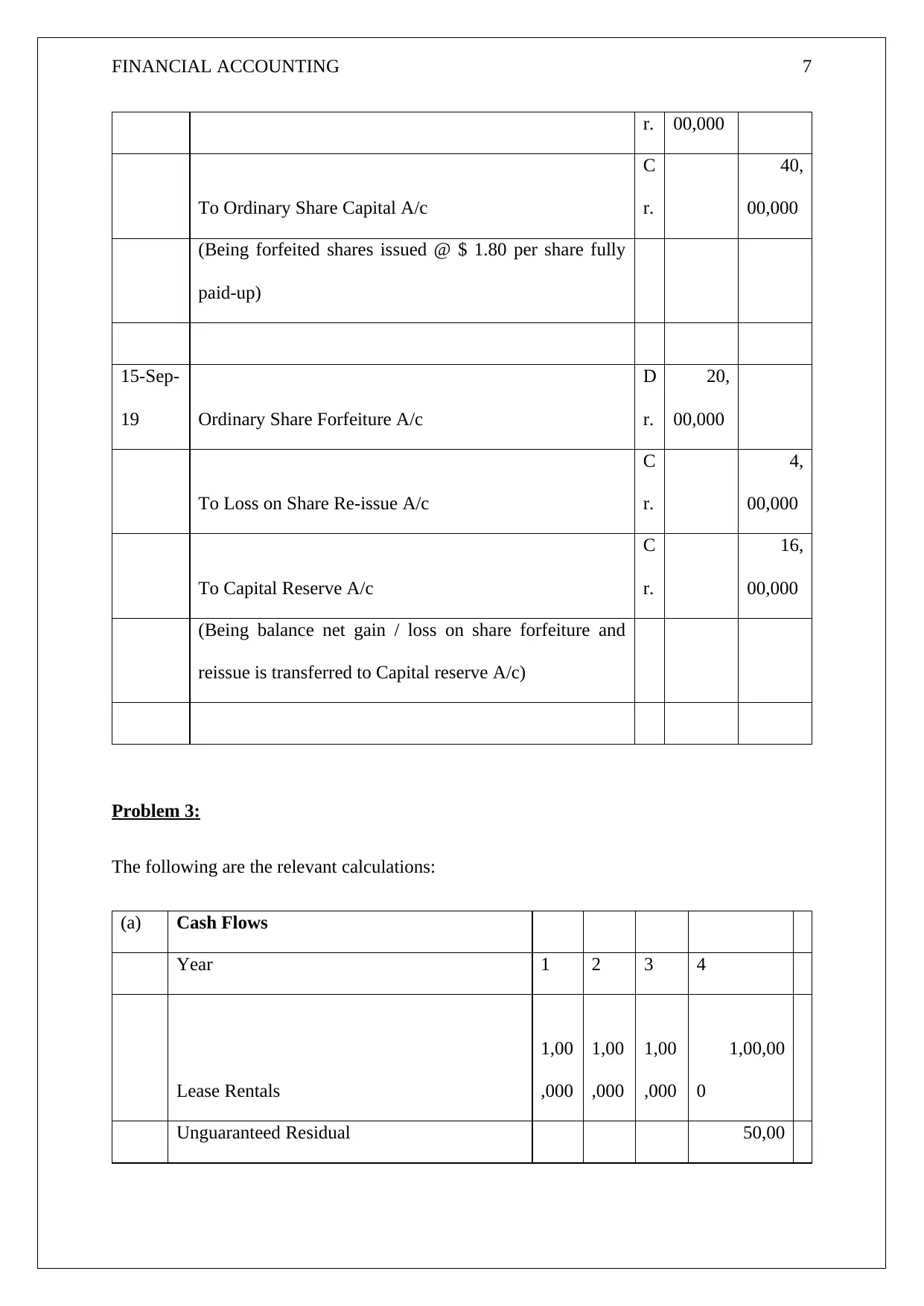
FINANCIAL ACCOUNTING 7
r. 00,000
To Ordinary Share Capital A/c
C
r.
40,
00,000
(Being forfeited shares issued @ $ 1.80 per share fully
paid-up)
15-Sep-
19 Ordinary Share Forfeiture A/c
D
r.
20,
00,000
To Loss on Share Re-issue A/c
C
r.
4,
00,000
To Capital Reserve A/c
C
r.
16,
00,000
(Being balance net gain / loss on share forfeiture and
reissue is transferred to Capital reserve A/c)
Problem 3:
The following are the relevant calculations:
(a) Cash Flows
Year 1 2 3 4
Lease Rentals
1,00
,000
1,00
,000
1,00
,000
1,00,00
0
Unguaranteed Residual 50,00
r. 00,000
To Ordinary Share Capital A/c
C
r.
40,
00,000
(Being forfeited shares issued @ $ 1.80 per share fully
paid-up)
15-Sep-
19 Ordinary Share Forfeiture A/c
D
r.
20,
00,000
To Loss on Share Re-issue A/c
C
r.
4,
00,000
To Capital Reserve A/c
C
r.
16,
00,000
(Being balance net gain / loss on share forfeiture and
reissue is transferred to Capital reserve A/c)
Problem 3:
The following are the relevant calculations:
(a) Cash Flows
Year 1 2 3 4
Lease Rentals
1,00
,000
1,00
,000
1,00
,000
1,00,00
0
Unguaranteed Residual 50,00
Paraphrase This Document
Need a fresh take? Get an instant paraphrase of this document with our AI Paraphraser
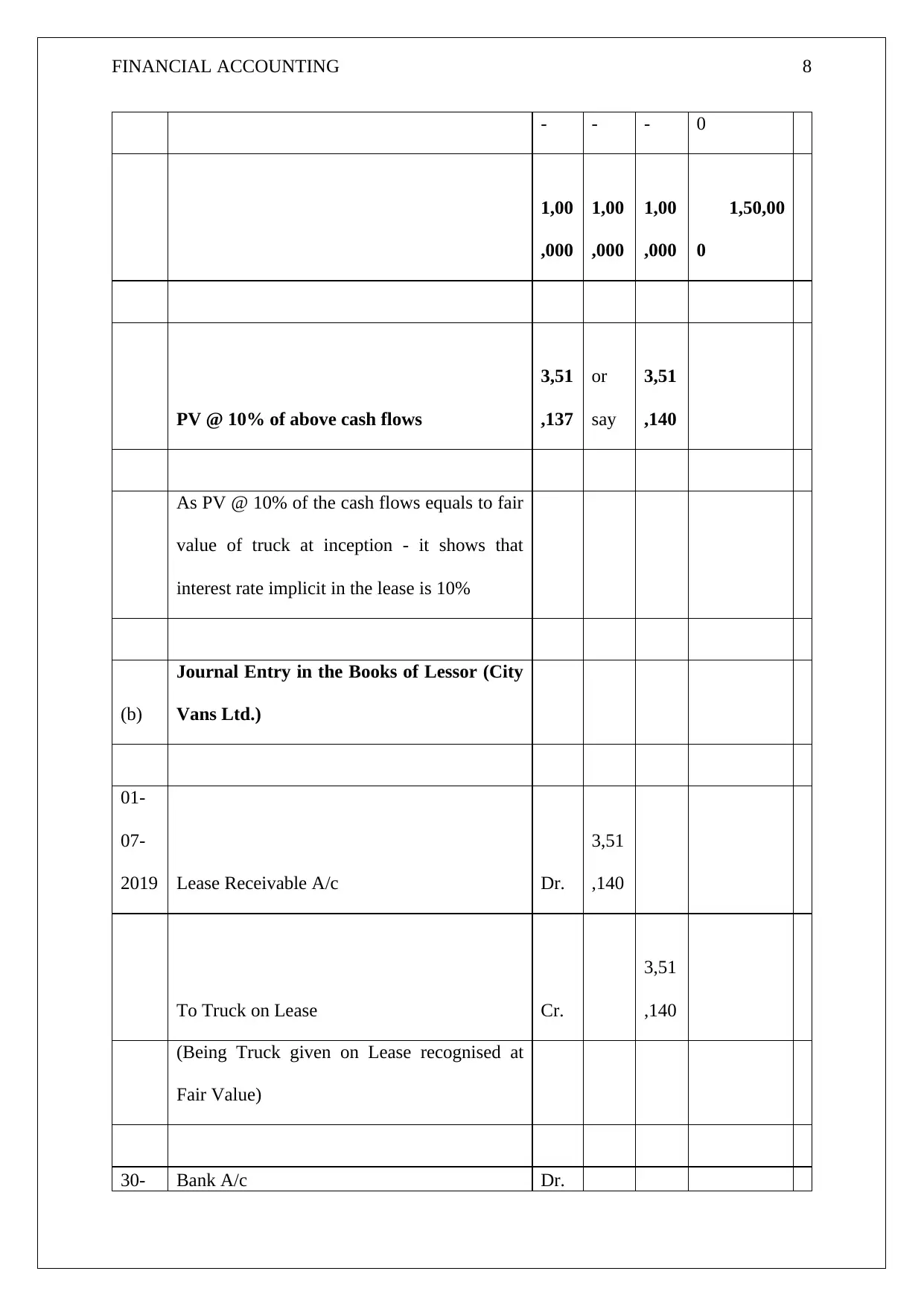
FINANCIAL ACCOUNTING 8
- - - 0
1,00
,000
1,00
,000
1,00
,000
1,50,00
0
PV @ 10% of above cash flows
3,51
,137
or
say
3,51
,140
As PV @ 10% of the cash flows equals to fair
value of truck at inception - it shows that
interest rate implicit in the lease is 10%
(b)
Journal Entry in the Books of Lessor (City
Vans Ltd.)
01-
07-
2019 Lease Receivable A/c Dr.
3,51
,140
To Truck on Lease Cr.
3,51
,140
(Being Truck given on Lease recognised at
Fair Value)
30- Bank A/c Dr.
- - - 0
1,00
,000
1,00
,000
1,00
,000
1,50,00
0
PV @ 10% of above cash flows
3,51
,137
or
say
3,51
,140
As PV @ 10% of the cash flows equals to fair
value of truck at inception - it shows that
interest rate implicit in the lease is 10%
(b)
Journal Entry in the Books of Lessor (City
Vans Ltd.)
01-
07-
2019 Lease Receivable A/c Dr.
3,51
,140
To Truck on Lease Cr.
3,51
,140
(Being Truck given on Lease recognised at
Fair Value)
30- Bank A/c Dr.
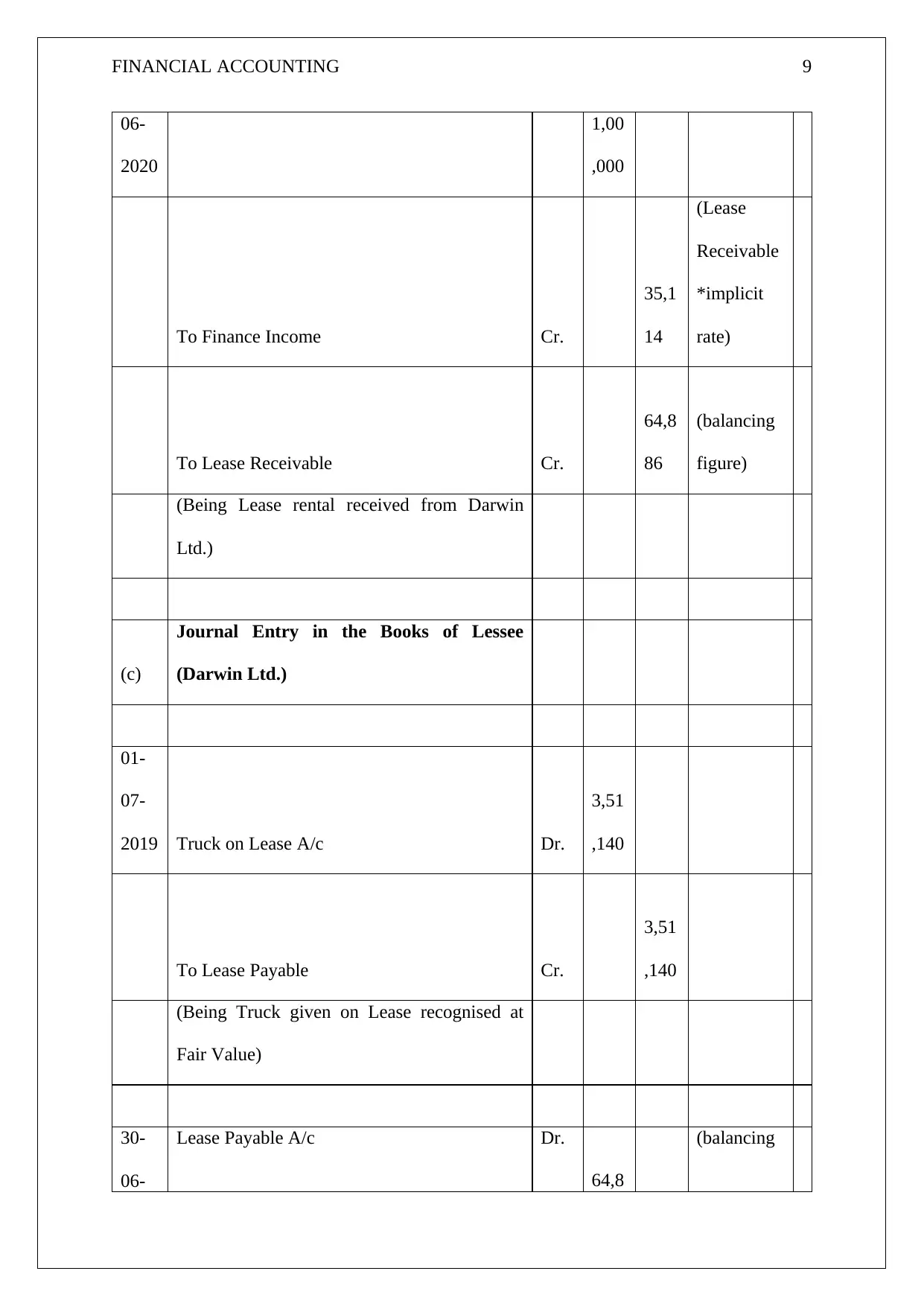
FINANCIAL ACCOUNTING 9
06-
2020
1,00
,000
To Finance Income Cr.
35,1
14
(Lease
Receivable
*implicit
rate)
To Lease Receivable Cr.
64,8
86
(balancing
figure)
(Being Lease rental received from Darwin
Ltd.)
(c)
Journal Entry in the Books of Lessee
(Darwin Ltd.)
01-
07-
2019 Truck on Lease A/c Dr.
3,51
,140
To Lease Payable Cr.
3,51
,140
(Being Truck given on Lease recognised at
Fair Value)
30-
06-
Lease Payable A/c Dr.
64,8
(balancing
06-
2020
1,00
,000
To Finance Income Cr.
35,1
14
(Lease
Receivable
*implicit
rate)
To Lease Receivable Cr.
64,8
86
(balancing
figure)
(Being Lease rental received from Darwin
Ltd.)
(c)
Journal Entry in the Books of Lessee
(Darwin Ltd.)
01-
07-
2019 Truck on Lease A/c Dr.
3,51
,140
To Lease Payable Cr.
3,51
,140
(Being Truck given on Lease recognised at
Fair Value)
30-
06-
Lease Payable A/c Dr.
64,8
(balancing
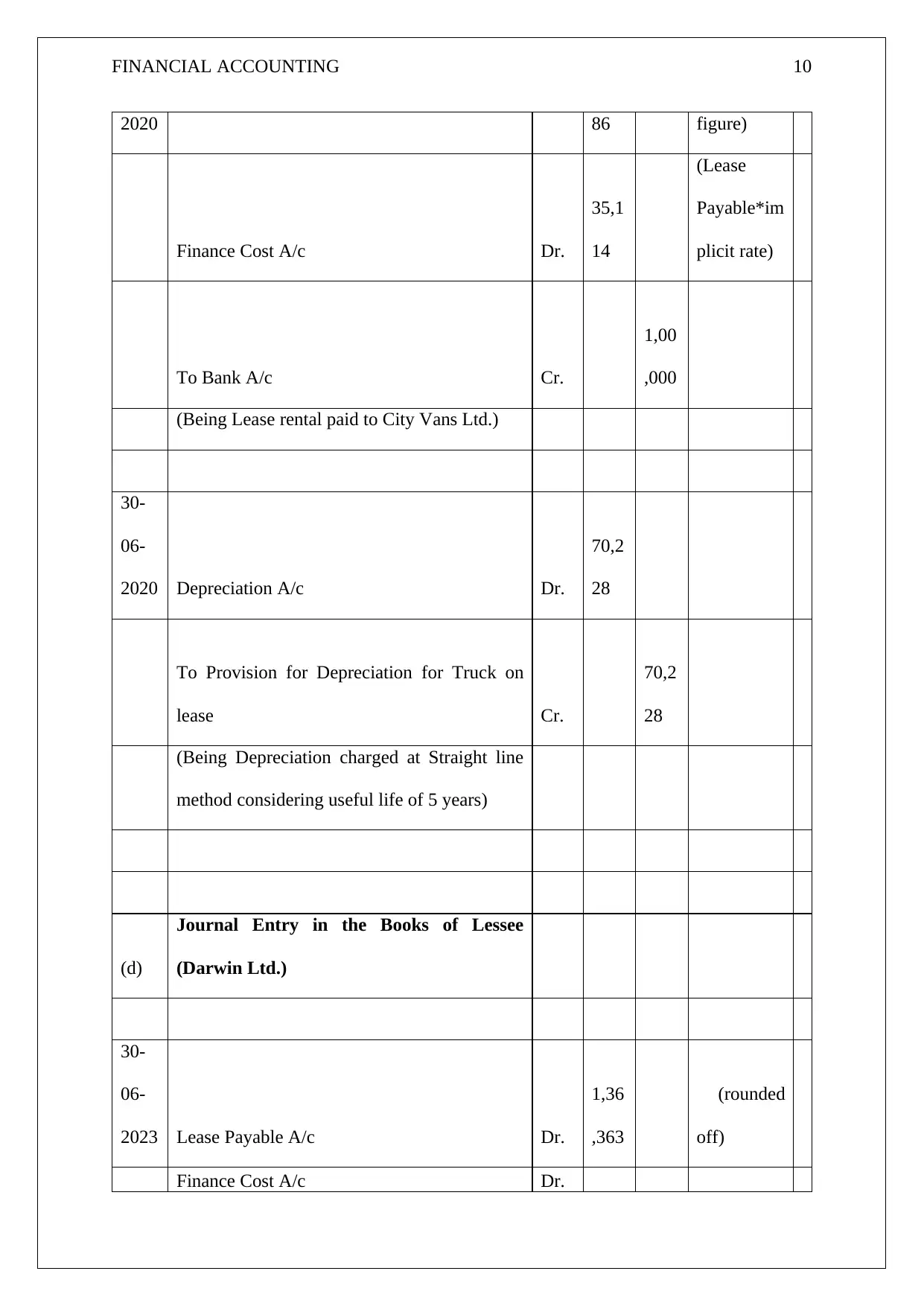
FINANCIAL ACCOUNTING 10
2020 86 figure)
Finance Cost A/c Dr.
35,1
14
(Lease
Payable*im
plicit rate)
To Bank A/c Cr.
1,00
,000
(Being Lease rental paid to City Vans Ltd.)
30-
06-
2020 Depreciation A/c Dr.
70,2
28
To Provision for Depreciation for Truck on
lease Cr.
70,2
28
(Being Depreciation charged at Straight line
method considering useful life of 5 years)
(d)
Journal Entry in the Books of Lessee
(Darwin Ltd.)
30-
06-
2023 Lease Payable A/c Dr.
1,36
,363
(rounded
off)
Finance Cost A/c Dr.
2020 86 figure)
Finance Cost A/c Dr.
35,1
14
(Lease
Payable*im
plicit rate)
To Bank A/c Cr.
1,00
,000
(Being Lease rental paid to City Vans Ltd.)
30-
06-
2020 Depreciation A/c Dr.
70,2
28
To Provision for Depreciation for Truck on
lease Cr.
70,2
28
(Being Depreciation charged at Straight line
method considering useful life of 5 years)
(d)
Journal Entry in the Books of Lessee
(Darwin Ltd.)
30-
06-
2023 Lease Payable A/c Dr.
1,36
,363
(rounded
off)
Finance Cost A/c Dr.
Secure Best Marks with AI Grader
Need help grading? Try our AI Grader for instant feedback on your assignments.
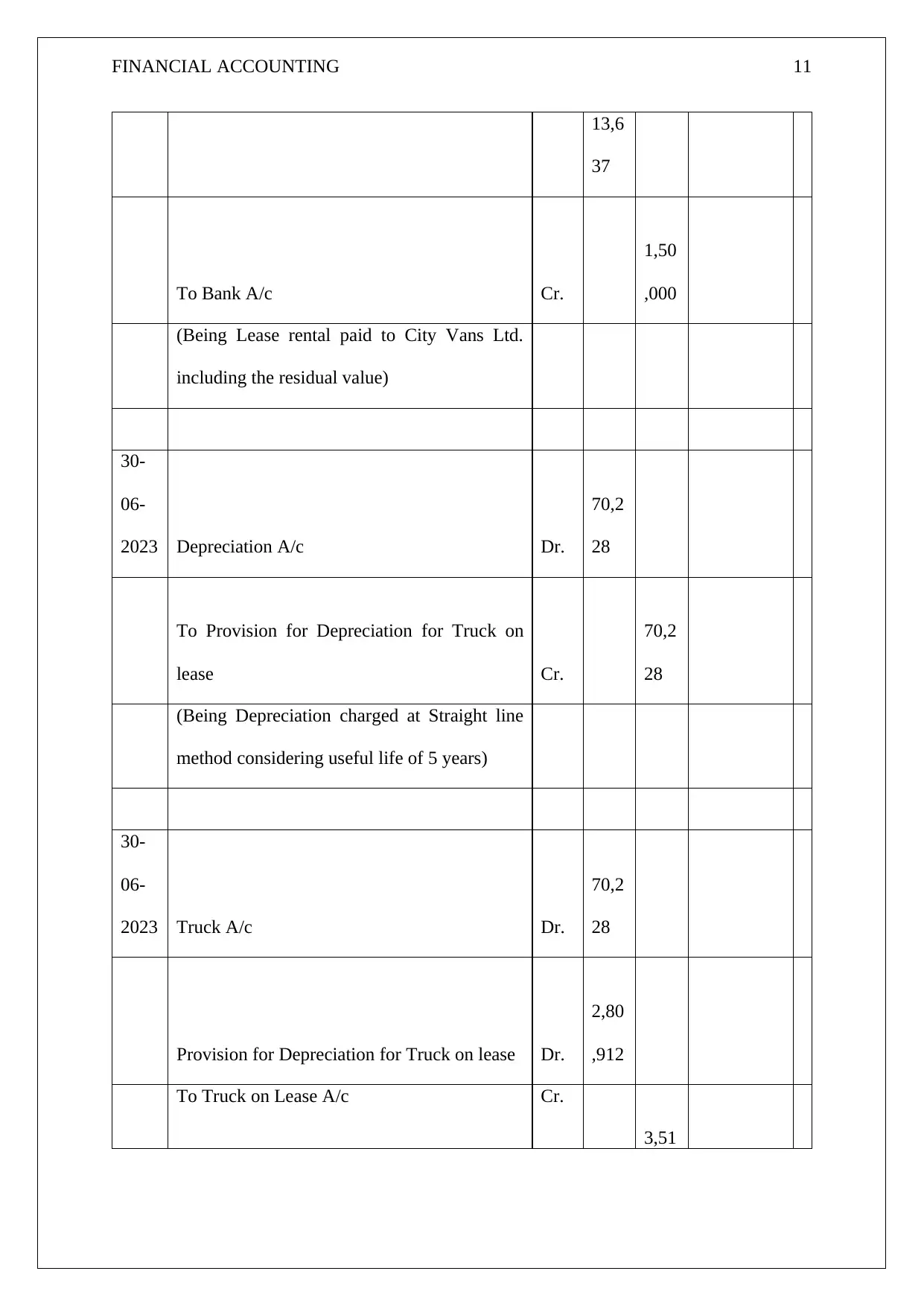
FINANCIAL ACCOUNTING 11
13,6
37
To Bank A/c Cr.
1,50
,000
(Being Lease rental paid to City Vans Ltd.
including the residual value)
30-
06-
2023 Depreciation A/c Dr.
70,2
28
To Provision for Depreciation for Truck on
lease Cr.
70,2
28
(Being Depreciation charged at Straight line
method considering useful life of 5 years)
30-
06-
2023 Truck A/c Dr.
70,2
28
Provision for Depreciation for Truck on lease Dr.
2,80
,912
To Truck on Lease A/c Cr.
3,51
13,6
37
To Bank A/c Cr.
1,50
,000
(Being Lease rental paid to City Vans Ltd.
including the residual value)
30-
06-
2023 Depreciation A/c Dr.
70,2
28
To Provision for Depreciation for Truck on
lease Cr.
70,2
28
(Being Depreciation charged at Straight line
method considering useful life of 5 years)
30-
06-
2023 Truck A/c Dr.
70,2
28
Provision for Depreciation for Truck on lease Dr.
2,80
,912
To Truck on Lease A/c Cr.
3,51
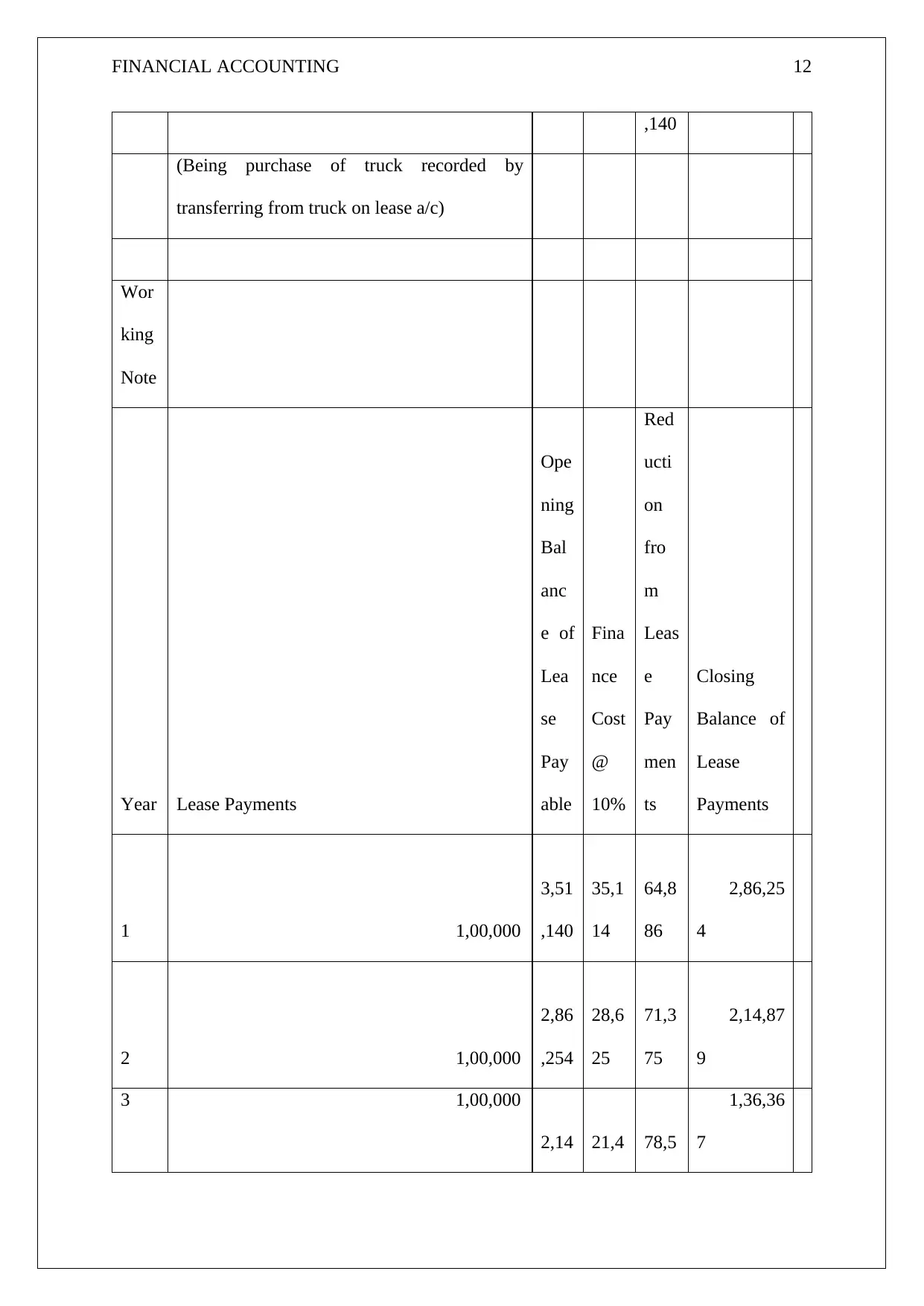
FINANCIAL ACCOUNTING 12
,140
(Being purchase of truck recorded by
transferring from truck on lease a/c)
Wor
king
Note
Year Lease Payments
Ope
ning
Bal
anc
e of
Lea
se
Pay
able
Fina
nce
Cost
@
10%
Red
ucti
on
fro
m
Leas
e
Pay
men
ts
Closing
Balance of
Lease
Payments
1 1,00,000
3,51
,140
35,1
14
64,8
86
2,86,25
4
2 1,00,000
2,86
,254
28,6
25
71,3
75
2,14,87
9
3 1,00,000
2,14 21,4 78,5
1,36,36
7
,140
(Being purchase of truck recorded by
transferring from truck on lease a/c)
Wor
king
Note
Year Lease Payments
Ope
ning
Bal
anc
e of
Lea
se
Pay
able
Fina
nce
Cost
@
10%
Red
ucti
on
fro
m
Leas
e
Pay
men
ts
Closing
Balance of
Lease
Payments
1 1,00,000
3,51
,140
35,1
14
64,8
86
2,86,25
4
2 1,00,000
2,86
,254
28,6
25
71,3
75
2,14,87
9
3 1,00,000
2,14 21,4 78,5
1,36,36
7
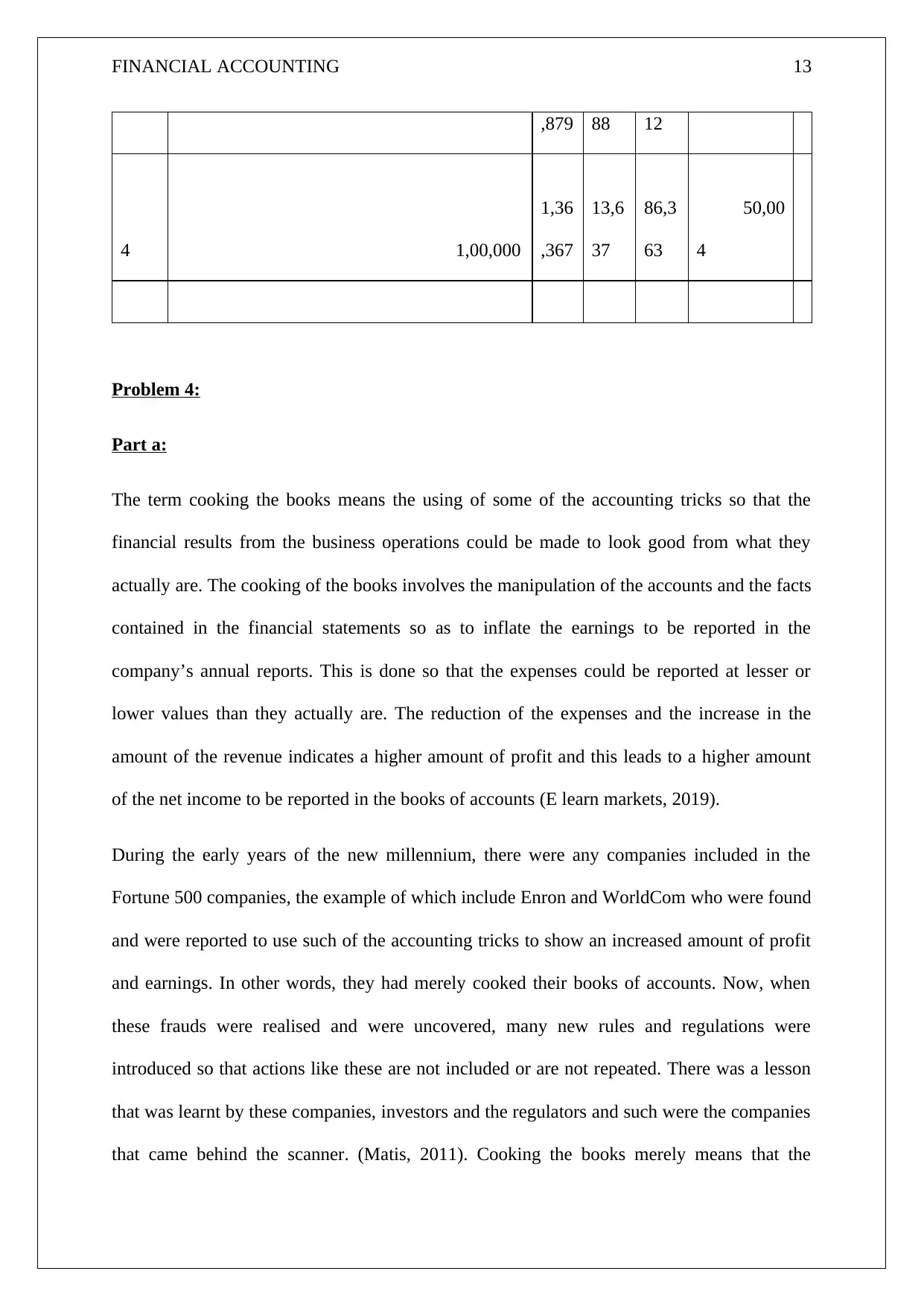
FINANCIAL ACCOUNTING 13
,879 88 12
4 1,00,000
1,36
,367
13,6
37
86,3
63
50,00
4
Problem 4:
Part a:
The term cooking the books means the using of some of the accounting tricks so that the
financial results from the business operations could be made to look good from what they
actually are. The cooking of the books involves the manipulation of the accounts and the facts
contained in the financial statements so as to inflate the earnings to be reported in the
company’s annual reports. This is done so that the expenses could be reported at lesser or
lower values than they actually are. The reduction of the expenses and the increase in the
amount of the revenue indicates a higher amount of profit and this leads to a higher amount
of the net income to be reported in the books of accounts (E learn markets, 2019).
During the early years of the new millennium, there were any companies included in the
Fortune 500 companies, the example of which include Enron and WorldCom who were found
and were reported to use such of the accounting tricks to show an increased amount of profit
and earnings. In other words, they had merely cooked their books of accounts. Now, when
these frauds were realised and were uncovered, many new rules and regulations were
introduced so that actions like these are not included or are not repeated. There was a lesson
that was learnt by these companies, investors and the regulators and such were the companies
that came behind the scanner. (Matis, 2011). Cooking the books merely means that the
,879 88 12
4 1,00,000
1,36
,367
13,6
37
86,3
63
50,00
4
Problem 4:
Part a:
The term cooking the books means the using of some of the accounting tricks so that the
financial results from the business operations could be made to look good from what they
actually are. The cooking of the books involves the manipulation of the accounts and the facts
contained in the financial statements so as to inflate the earnings to be reported in the
company’s annual reports. This is done so that the expenses could be reported at lesser or
lower values than they actually are. The reduction of the expenses and the increase in the
amount of the revenue indicates a higher amount of profit and this leads to a higher amount
of the net income to be reported in the books of accounts (E learn markets, 2019).
During the early years of the new millennium, there were any companies included in the
Fortune 500 companies, the example of which include Enron and WorldCom who were found
and were reported to use such of the accounting tricks to show an increased amount of profit
and earnings. In other words, they had merely cooked their books of accounts. Now, when
these frauds were realised and were uncovered, many new rules and regulations were
introduced so that actions like these are not included or are not repeated. There was a lesson
that was learnt by these companies, investors and the regulators and such were the companies
that came behind the scanner. (Matis, 2011). Cooking the books merely means that the
Paraphrase This Document
Need a fresh take? Get an instant paraphrase of this document with our AI Paraphraser
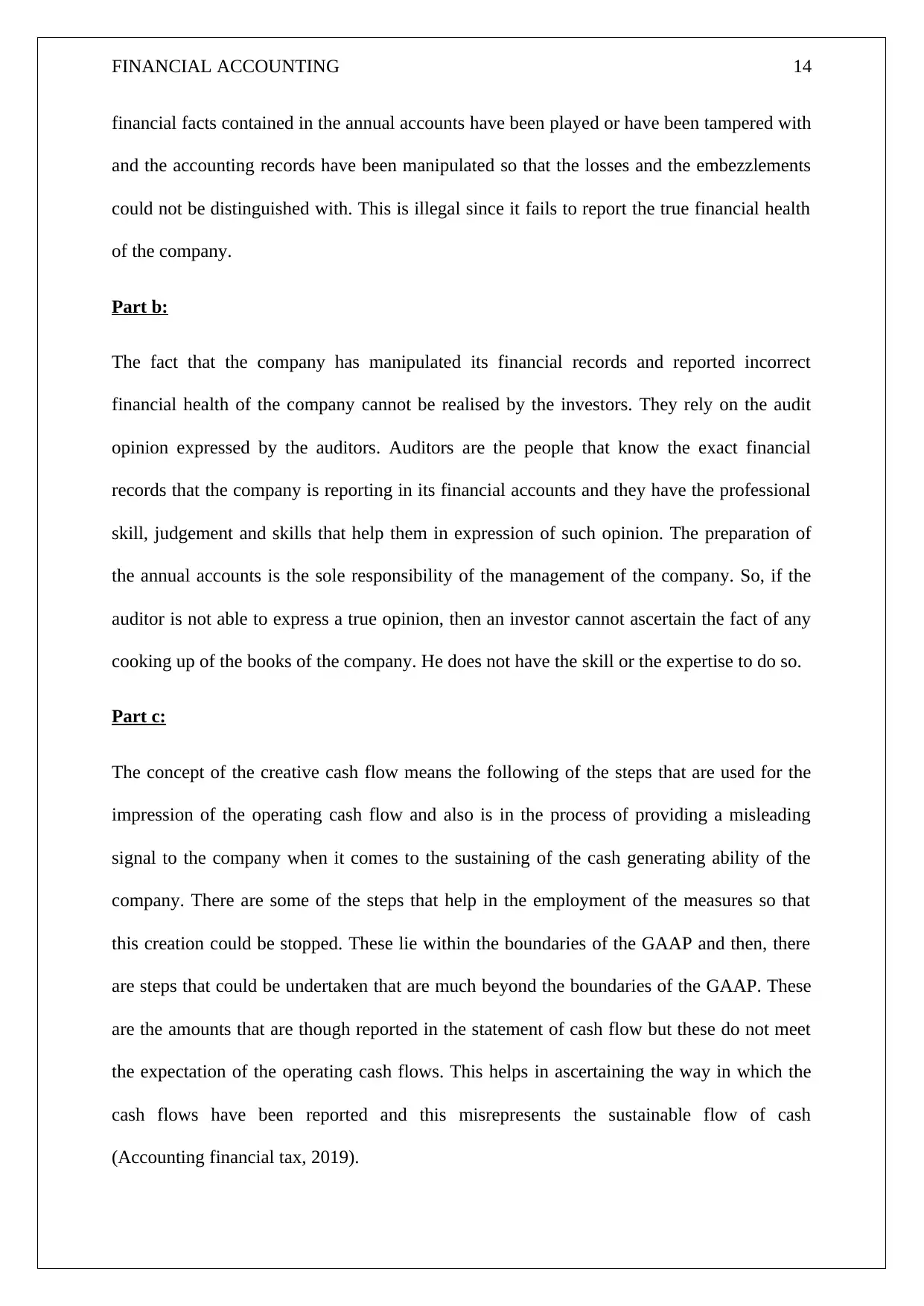
FINANCIAL ACCOUNTING 14
financial facts contained in the annual accounts have been played or have been tampered with
and the accounting records have been manipulated so that the losses and the embezzlements
could not be distinguished with. This is illegal since it fails to report the true financial health
of the company.
Part b:
The fact that the company has manipulated its financial records and reported incorrect
financial health of the company cannot be realised by the investors. They rely on the audit
opinion expressed by the auditors. Auditors are the people that know the exact financial
records that the company is reporting in its financial accounts and they have the professional
skill, judgement and skills that help them in expression of such opinion. The preparation of
the annual accounts is the sole responsibility of the management of the company. So, if the
auditor is not able to express a true opinion, then an investor cannot ascertain the fact of any
cooking up of the books of the company. He does not have the skill or the expertise to do so.
Part c:
The concept of the creative cash flow means the following of the steps that are used for the
impression of the operating cash flow and also is in the process of providing a misleading
signal to the company when it comes to the sustaining of the cash generating ability of the
company. There are some of the steps that help in the employment of the measures so that
this creation could be stopped. These lie within the boundaries of the GAAP and then, there
are steps that could be undertaken that are much beyond the boundaries of the GAAP. These
are the amounts that are though reported in the statement of cash flow but these do not meet
the expectation of the operating cash flows. This helps in ascertaining the way in which the
cash flows have been reported and this misrepresents the sustainable flow of cash
(Accounting financial tax, 2019).
financial facts contained in the annual accounts have been played or have been tampered with
and the accounting records have been manipulated so that the losses and the embezzlements
could not be distinguished with. This is illegal since it fails to report the true financial health
of the company.
Part b:
The fact that the company has manipulated its financial records and reported incorrect
financial health of the company cannot be realised by the investors. They rely on the audit
opinion expressed by the auditors. Auditors are the people that know the exact financial
records that the company is reporting in its financial accounts and they have the professional
skill, judgement and skills that help them in expression of such opinion. The preparation of
the annual accounts is the sole responsibility of the management of the company. So, if the
auditor is not able to express a true opinion, then an investor cannot ascertain the fact of any
cooking up of the books of the company. He does not have the skill or the expertise to do so.
Part c:
The concept of the creative cash flow means the following of the steps that are used for the
impression of the operating cash flow and also is in the process of providing a misleading
signal to the company when it comes to the sustaining of the cash generating ability of the
company. There are some of the steps that help in the employment of the measures so that
this creation could be stopped. These lie within the boundaries of the GAAP and then, there
are steps that could be undertaken that are much beyond the boundaries of the GAAP. These
are the amounts that are though reported in the statement of cash flow but these do not meet
the expectation of the operating cash flows. This helps in ascertaining the way in which the
cash flows have been reported and this misrepresents the sustainable flow of cash
(Accounting financial tax, 2019).
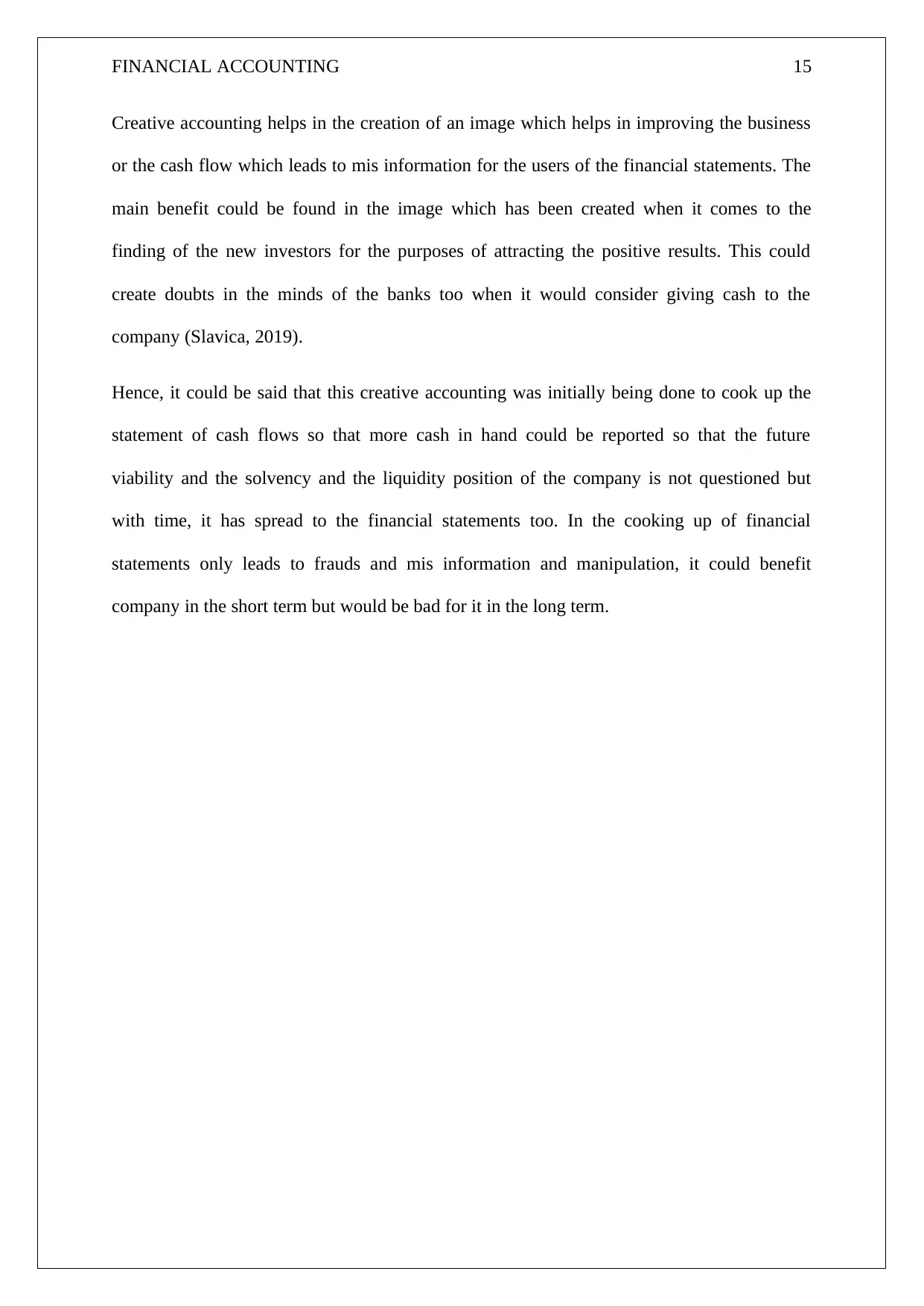
FINANCIAL ACCOUNTING 15
Creative accounting helps in the creation of an image which helps in improving the business
or the cash flow which leads to mis information for the users of the financial statements. The
main benefit could be found in the image which has been created when it comes to the
finding of the new investors for the purposes of attracting the positive results. This could
create doubts in the minds of the banks too when it would consider giving cash to the
company (Slavica, 2019).
Hence, it could be said that this creative accounting was initially being done to cook up the
statement of cash flows so that more cash in hand could be reported so that the future
viability and the solvency and the liquidity position of the company is not questioned but
with time, it has spread to the financial statements too. In the cooking up of financial
statements only leads to frauds and mis information and manipulation, it could benefit
company in the short term but would be bad for it in the long term.
Creative accounting helps in the creation of an image which helps in improving the business
or the cash flow which leads to mis information for the users of the financial statements. The
main benefit could be found in the image which has been created when it comes to the
finding of the new investors for the purposes of attracting the positive results. This could
create doubts in the minds of the banks too when it would consider giving cash to the
company (Slavica, 2019).
Hence, it could be said that this creative accounting was initially being done to cook up the
statement of cash flows so that more cash in hand could be reported so that the future
viability and the solvency and the liquidity position of the company is not questioned but
with time, it has spread to the financial statements too. In the cooking up of financial
statements only leads to frauds and mis information and manipulation, it could benefit
company in the short term but would be bad for it in the long term.
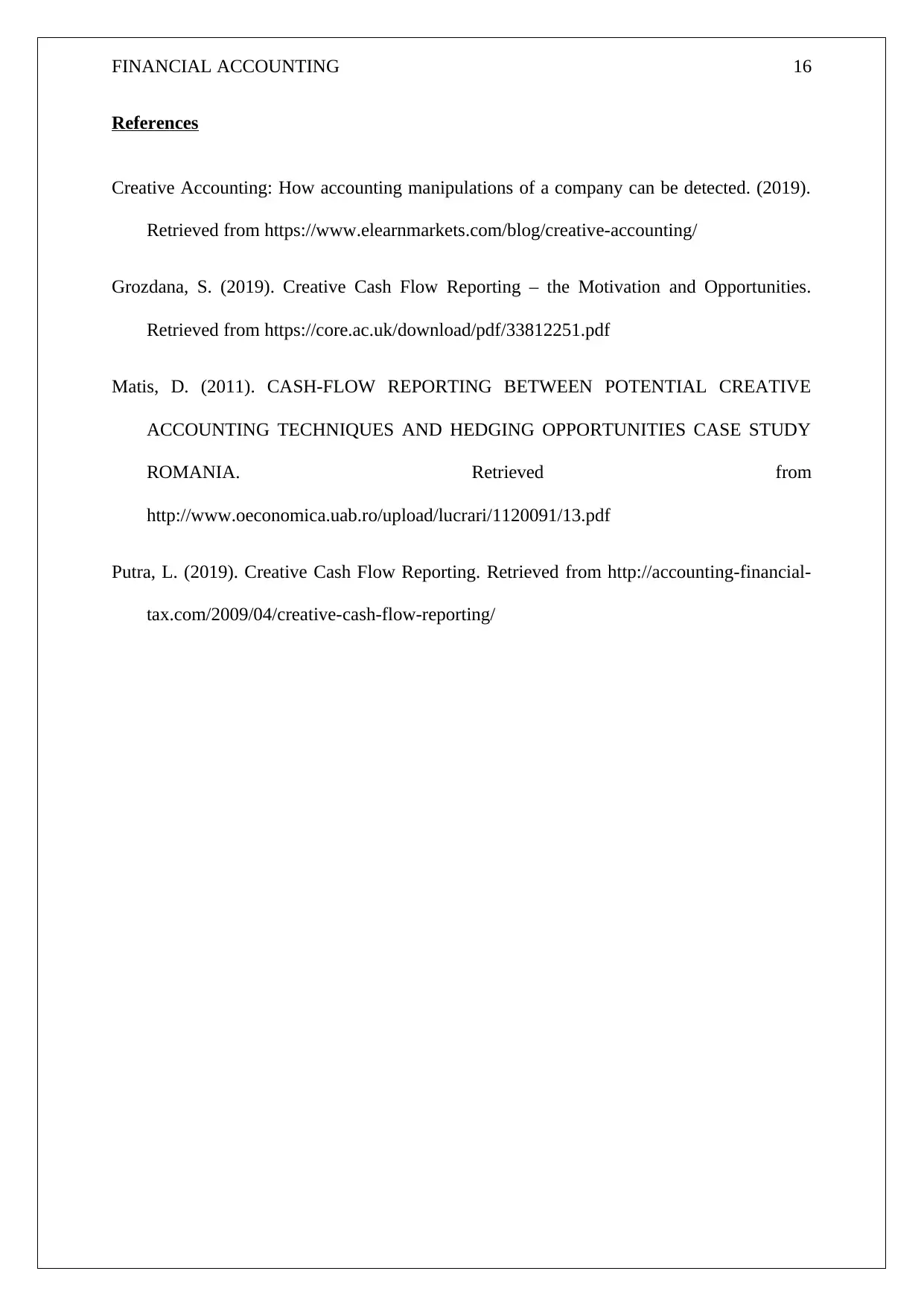
FINANCIAL ACCOUNTING 16
References
Creative Accounting: How accounting manipulations of a company can be detected. (2019).
Retrieved from https://www.elearnmarkets.com/blog/creative-accounting/
Grozdana, S. (2019). Creative Cash Flow Reporting – the Motivation and Opportunities.
Retrieved from https://core.ac.uk/download/pdf/33812251.pdf
Matis, D. (2011). CASH-FLOW REPORTING BETWEEN POTENTIAL CREATIVE
ACCOUNTING TECHNIQUES AND HEDGING OPPORTUNITIES CASE STUDY
ROMANIA. Retrieved from
http://www.oeconomica.uab.ro/upload/lucrari/1120091/13.pdf
Putra, L. (2019). Creative Cash Flow Reporting. Retrieved from http://accounting-financial-
tax.com/2009/04/creative-cash-flow-reporting/
References
Creative Accounting: How accounting manipulations of a company can be detected. (2019).
Retrieved from https://www.elearnmarkets.com/blog/creative-accounting/
Grozdana, S. (2019). Creative Cash Flow Reporting – the Motivation and Opportunities.
Retrieved from https://core.ac.uk/download/pdf/33812251.pdf
Matis, D. (2011). CASH-FLOW REPORTING BETWEEN POTENTIAL CREATIVE
ACCOUNTING TECHNIQUES AND HEDGING OPPORTUNITIES CASE STUDY
ROMANIA. Retrieved from
http://www.oeconomica.uab.ro/upload/lucrari/1120091/13.pdf
Putra, L. (2019). Creative Cash Flow Reporting. Retrieved from http://accounting-financial-
tax.com/2009/04/creative-cash-flow-reporting/
1 out of 16
Your All-in-One AI-Powered Toolkit for Academic Success.
+13062052269
info@desklib.com
Available 24*7 on WhatsApp / Email
![[object Object]](/_next/static/media/star-bottom.7253800d.svg)
Unlock your academic potential
© 2024 | Zucol Services PVT LTD | All rights reserved.